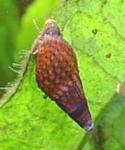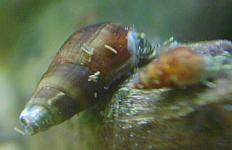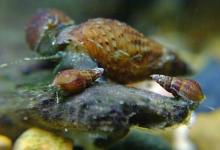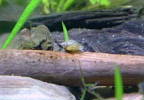Controlling Snail Populations in the Home Aquaria
There are generally four ways to deal with an unexpected (or maybe intentionally introduced) snail population in your tank.
 Method 1) Snail eating fish. This is generally the solution that requires the least amount of intervention by you plus you might get some new and interesting fish in the deal. How much your snail populations declines depends on the type of fish you decide to use (some are better at it than others) and how much you feed those fish (plenty of prepared foods may make them lazy at eating snails). Also the type of snails you have may influence your fish's taste for snail eating. Generally, pond snails are the most commonly reported snail problem with aquarists and also the most readily accepted by snail eating fish.
Method 1) Snail eating fish. This is generally the solution that requires the least amount of intervention by you plus you might get some new and interesting fish in the deal. How much your snail populations declines depends on the type of fish you decide to use (some are better at it than others) and how much you feed those fish (plenty of prepared foods may make them lazy at eating snails). Also the type of snails you have may influence your fish's taste for snail eating. Generally, pond snails are the most commonly reported snail problem with aquarists and also the most readily accepted by snail eating fish.
Here is a partial list of some fish that are reported to eat snails in no particular order. This list was compiled from various sources including books, magazine articles, Usenet, web pages, and reports from other aquarists. I only have first hand knowledge with Clown Loaches and Bettas from this list. Others surely exist and if anyone would like to add to this list, please email me with the details.
BAA#:### = Baensch Aquarium Atlas volume #: page ### (Tetra Press editions)
- Clown Loaches (Botia macracantha) notes: community fish, schooling. BAA1:370
- Skunk Loach (Botia morleti, formerly Botia horae) (some say better than the Clown L.) BAA1:368
- Puffers (Tetraodon species) notes: aggressive, keep alone.
- Banjo catfish (Bunocephalus species)
- Malawi Cichlids (Pseudotropheus & Melanochromis)
- African Butterfly or Thomas' Cichlid (Anomalochromis thomasi). BAA1:748
- Malawi Cichlids (Pseudotropheus & Melanochromis species)
- Yellow Labs, Electric Yellow (Labidochromis caeruleus) (Malawi Cichlid)
- Chocolate Cichlid (Cichlasoma coryphaenoides / C. hellabruni)
- Asian Bumblebee catfish (Leiocassis siamensis) BAA2:450
- Giant Gourami (Osphronemus goramy) notes: VERY large, not recommended!
- Betta/Fighting Fish (Betta splendens) notes: some do, some don't. BAA1:632
- Keyhole cichlid (Aequidens maronii). BAA1:668.
- Black ghost knifefish (Gymnotidae family)
- various Lake Tanganyika Synodontis catfish species
- Red Devil Cichlid (Amphilophus labiatus) (C.America)
- Slender Bumphead Cichlid (Steatocranus gibbiceps) (Tanganyika)
- Black-Banded Leporinus (Leporinus fasciatus) S. American, large, may eat smaller fish.
These are listed in a book I have (Drs. Andrew & Baensch) as being snail eaters, but one person who has bred both claims they do not eat snails.
In addition, most other Botia species eat snails as well, but I didn't list any specific ones other than Clown & Skunk Loaches. Also it is a good bet that a large percentage of African cichlids will eat snails besides the ones listed above.
 Method 2) manually removing snails. This includes just reaching into the tank and picking them out as you see them. You could also crush them against the glass. Most fish readily eat them once you have crushed the shells. Other methods include putting a piece of food on an overturned dish and leaving in the tank for a few hours after lights out. Snails will converge on the plate. Lift out plate and dispose of snails. Of course many bottom feeders (such as Cory Cats) usually eat the food first. People have reported good results with other foods like a leaf of lettuce.
Method 2) manually removing snails. This includes just reaching into the tank and picking them out as you see them. You could also crush them against the glass. Most fish readily eat them once you have crushed the shells. Other methods include putting a piece of food on an overturned dish and leaving in the tank for a few hours after lights out. Snails will converge on the plate. Lift out plate and dispose of snails. Of course many bottom feeders (such as Cory Cats) usually eat the food first. People have reported good results with other foods like a leaf of lettuce.
One interesting method sent to me was as follows:
From: Apflanzeneh@webtv.net Date: 16 Jun 1998
My method: Poke 3 holes in 35mm film cannister lid, place algae wafer
inside, replace lid, plunge into substrate leaving lid level with
substrate , go to bed , wake up in morning remove film cannister and
empty. Repeat as needed.
Steve in sunny Vancouver B.C
Note, these methods usually never rid your tank of the problem. Rather, they merely keep the population in check. Often after an initial week of snail warfare (nightly lettuce leaves or hours each day picking them out) it will only require the occasional intervention to keep the numbers from getting out of control again. Of course this method also requires lots of work from you and continues to do so. If you are lazy, you might opt for Method 1) above.
 Method 3) snail killing chemicals. These are sold in most pet shops. This method is one of the most severe and I can not really suggest it. For one thing, anything designed to kill snails probably isn't all that great for your fish and plants. Adding chemicals to your tank is always a risky thing unless you know exactly what you are adding and exactly what the effects will be. Most of these snail killing chemicals use high levels of copper.
Method 3) snail killing chemicals. These are sold in most pet shops. This method is one of the most severe and I can not really suggest it. For one thing, anything designed to kill snails probably isn't all that great for your fish and plants. Adding chemicals to your tank is always a risky thing unless you know exactly what you are adding and exactly what the effects will be. Most of these snail killing chemicals use high levels of copper.
Also, even if the chemicals turn out to be harmless to your fish, the often overlooked result of this method is the massive die off of snails and the resulting decaying of all those little snail bodies. This can often be more deadly to your fish than many of the chemicals used to kill the snails. If you do choose to go this route, follow up the treatment with plenty of small partial water changes. At least 10% every other day for a week if not more and make sure to check the filter often during this time. High ammonia levels is the most likely result and a daily check with an ammonia test kit after such a treatment is suggested.
 Method 4) complete tear down of the tank. Most people will try anything before turning to this, but sometimes the only SURE way to rid your tank of snails is to start over. This means cleaning EVERYTHING in the tank, gravel, filters, the tank itself, plants, the hood (yes eggs can still be there), etc. After this it is required to recycle your tank. Unless you have a place to hold your fish population in the meantime, this method probably isn't for you.
Method 4) complete tear down of the tank. Most people will try anything before turning to this, but sometimes the only SURE way to rid your tank of snails is to start over. This means cleaning EVERYTHING in the tank, gravel, filters, the tank itself, plants, the hood (yes eggs can still be there), etc. After this it is required to recycle your tank. Unless you have a place to hold your fish population in the meantime, this method probably isn't for you.
Above I have outlined some methods to help control your tank's snail population. They tend to be more "after the fact" solutions rather than preventative measures, although snail eating fish will always help prevent future problems. To help keep snail population from becoming a problem to begin with make sure you are only feeding your fish as much as they can eat within a few minutes or will completely consume once they start eating (like sinking wafers). Snails can only populate a tank to a level that the tank can sustain. With an over abundance of food in the tank, snails will multiply until there is enough to match the excess food problem. Eliminate over feeding and you effectively limit the number of snails that can live in your tank.
 One last thing you might want to think about is... Are snails really that bad? I personally don't think so. Some types might be more destructive than others, but many add yet another element to a tank that helps give it a more natural feel to it. Many snails even perform useful functions. Functions such as eating excess food and decaying plant matter, burrowing through the substrate thus preventing compacting and dead spots, and even to help dispose of dead fish. You aren't likely to notice that dead neon in the back of your heavily planted 75 gallon tank are you? My suggestion is to employ method one above and use fish to help you keep a useful population of snails in your tank while at the same time keeping the number of snails from getting out of hand.
One last thing you might want to think about is... Are snails really that bad? I personally don't think so. Some types might be more destructive than others, but many add yet another element to a tank that helps give it a more natural feel to it. Many snails even perform useful functions. Functions such as eating excess food and decaying plant matter, burrowing through the substrate thus preventing compacting and dead spots, and even to help dispose of dead fish. You aren't likely to notice that dead neon in the back of your heavily planted 75 gallon tank are you? My suggestion is to employ method one above and use fish to help you keep a useful population of snails in your tank while at the same time keeping the number of snails from getting out of hand.



Want to read this article in French? It has been translated and can be found at http://www.aquabase.org/articles/?id=1
For some additional information on aquatic snails, see an article written by George Booth at
http://faq.thekrib.com/snails.html
Any comments, suggesting, corrections, or additions to this
file, please email to
ptimlin@yahoo.com
Last modified: December 29, 2004
© 1996 - 2004 Patrick A. Timlin
Back to Aquaria
Back to Main Page (top level)
 Method 1) Snail eating fish. This is generally the solution that requires the least amount of intervention by you plus you might get some new and interesting fish in the deal. How much your snail populations declines depends on the type of fish you decide to use (some are better at it than others) and how much you feed those fish (plenty of prepared foods may make them lazy at eating snails). Also the type of snails you have may influence your fish's taste for snail eating. Generally, pond snails are the most commonly reported snail problem with aquarists and also the most readily accepted by snail eating fish.
Method 1) Snail eating fish. This is generally the solution that requires the least amount of intervention by you plus you might get some new and interesting fish in the deal. How much your snail populations declines depends on the type of fish you decide to use (some are better at it than others) and how much you feed those fish (plenty of prepared foods may make them lazy at eating snails). Also the type of snails you have may influence your fish's taste for snail eating. Generally, pond snails are the most commonly reported snail problem with aquarists and also the most readily accepted by snail eating fish.





